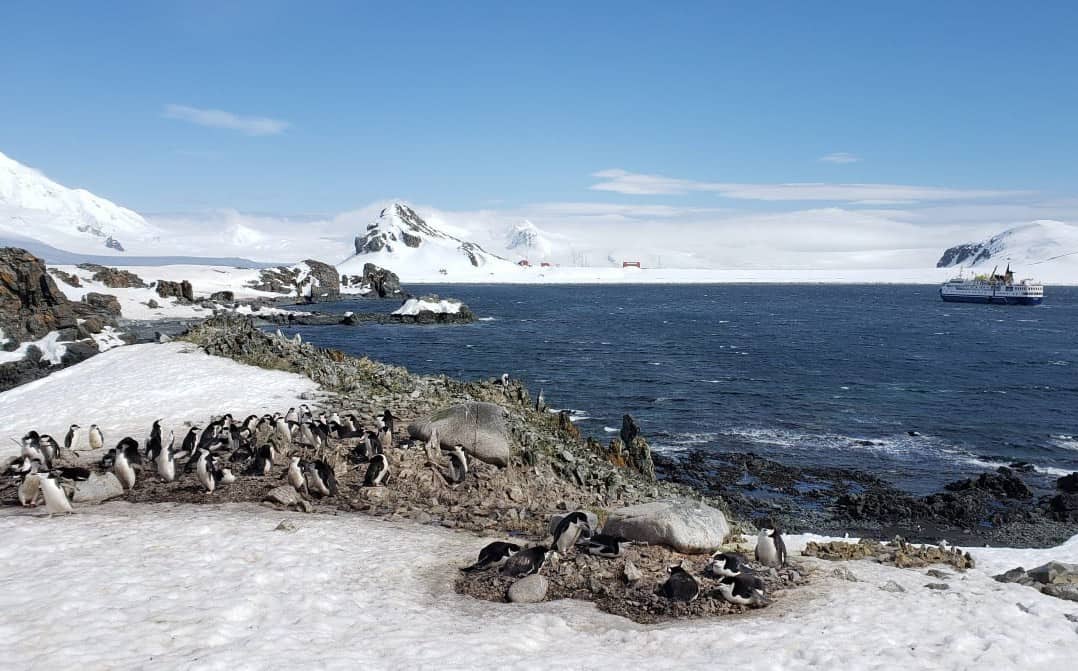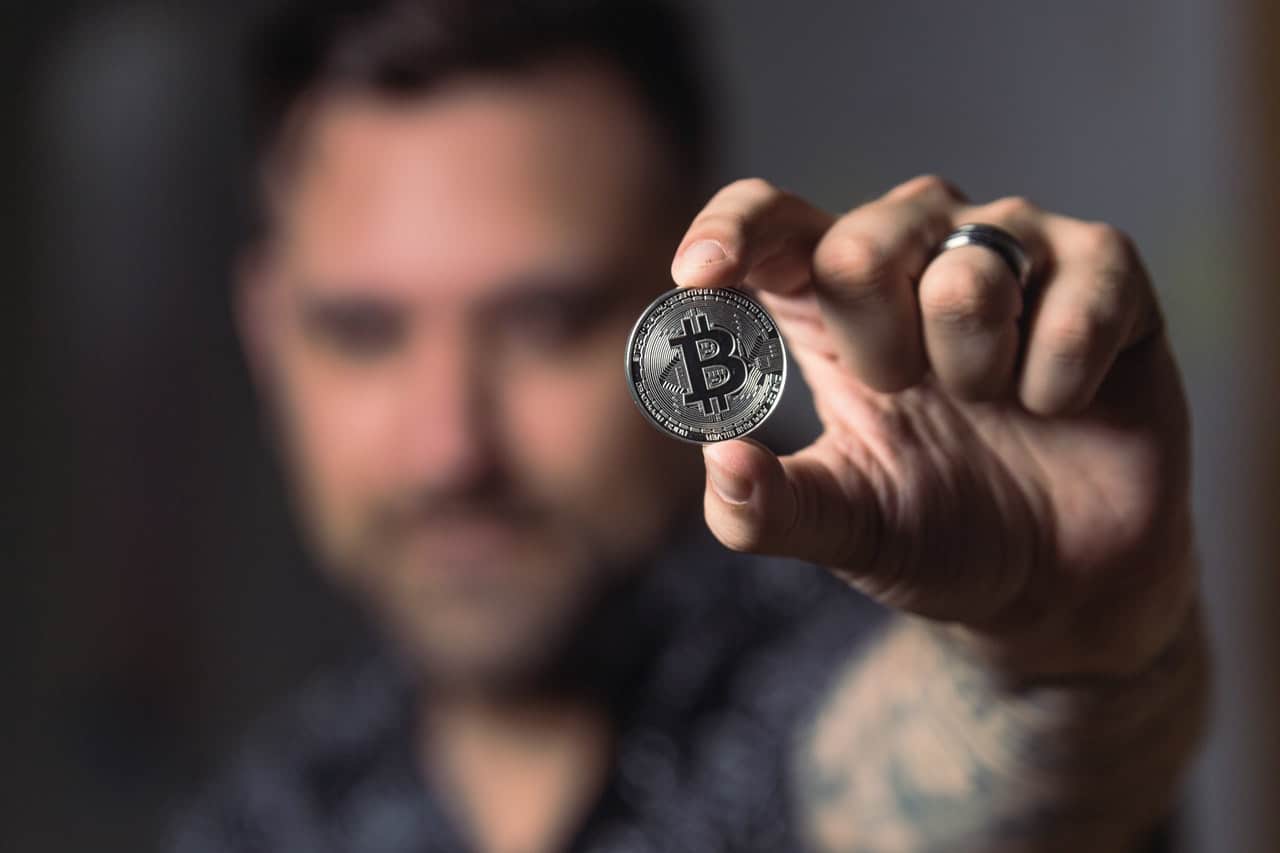Having spent the last few months travelling the globe to regions feeling the impact of the climate crisis (read her updates from the Great Barrier Reef and New Zealand’s glaciers), our globetrotting contributor Hannah Nicholl reports from Antarctica. Here’s the lowdown on how climate change is affecting the migration of penguins and whales, the problem with politics and commercial hunting, and… pink poop.
“In the lee of a snowy Antarctic promontory, on a warm patch of exposed rock, lives a colony of penguins. Approaching the shore by boat, the mass of birds looks like an inanimate slice of dark rock against the white backdrop. But trudging towards them through the thick snow, the noise – and the smell – of the penguins hit.
Imagine thousands of birds squawking at each other, tipping their heads back to call to their mates, waddling through the snow one by one, and sliding towards the water on their bellies. Under their feet, the snow and rocks were stained pink – a result of the smelly penguin faeces or ‘guano’ that the birds projectile-poop everywhere. By the end of the nesting season, there is so much guano that scientists can locate and size penguin colonies from space.

We need to talk about Kevin
Breathing heavily through my mouth (definitely not my nose), I surveyed the monochrome sea of chinstrap penguins before spotting a flash of yellow. An impostor stood quietly in the middle of the crowd. Kevin, as he has been dubbed by researchers, is in fact a Macaroni penguin, and has been a regular sight at this chinstrap colony for the past decade.
Every summer, the male chinstraps arrive at the nesting ground after a winter of feeding out at sea. They set about building their nests using pebbles from the shore, creating little penguin highways through the snow as they plod up and down. Some of the more cunning penguins steal pebbles from their neighbours – which normally results in a lot of indignant squawks and pecks. Penguins mate for life and their female partners arrive soon after the males. Mating involves the males awkwardly jumping on the backs of the females and trying desperately to cling on with their webbed feet, so you can identify the females from the grubby feathers on their backs.

Here comes the sad bit
Sadly Kevin does not get to take part in the romance. Every year he builds a nest, but his partner never comes. Although they are the most abundant species of penguin in the world, Macaronis don’t come this far south as it’s generally a bit too chilly for them. So why is Kevin here? One of the researchers on my expedition explained that after analysing DNA from one of Kevin’s feathers, they were able to deduce that he is related to the Macaroni penguins of South Georgia, 1,500 kilometres north. The theory? Kevin is an outlier penguin. As temperatures rise, he has ventured further south to explore new and potentially attractive environments as they warm up. But unfortunately, he’s a bit too ahead of the curve to find a mate who shares his lust for travel.
Kevin’s migration south is not a unique occurrence. Penguins are known to be adaptable when it comes to change. Even chinstraps are relatively new to these parts. After analysing nest evidence, scientists believe that chinstraps only made it to the Antarctic peninsular 150 years ago as conditions changed.
Whale hello there…
While watching the penguins squabble, a huge fountain of water burst out of the sea in the distance, followed by another smaller spout. It was a humpback whale and her calf, feeding in the calm waters of the bay. Whales too have been changing their established routines as a result of warming seas, travelling down to feed in Antarctica earlier than before.
Most of the whales in the Southern Ocean feed on krill; small, pink crustaceans that in turn eat phytoplankton (single-cell plants that float near the surface of the water and absorb the sun’s light). Sea ice is now melting more quickly than in the past, and as a result, these phytoplankton blooms are happening earlier. This results in the krill buffet at the beginning of the season, and earlier whale migration.
I stood on the shore, jumping up and down in excitement, as I watched the whales go about their business. Their explosive spouts of condensed water and spray make a noise that can be heard hundreds of metres away. They peacefully glide through the water before diving down, their tail following silently. One even had a shiny pink slick trailing it on the surface of the water. I commented on how pretty it was and was told it was poo…

There is some good news
Thanks to global efforts to ban commercial hunts in the 1980s, whale populations are finally starting to recover, after a century of whaling brought many species to the brink of extinction. However, the recovery is slow. Humpback whales like the ones I saw have made one of the strongest comebacks, returning to a third of their original pre-whaling population. Species like Blue whales have had a more difficult recovery. In their heyday, scientists believe Antarctic waters were home to around 200,000 Blue whales. But their numbers in the Southern Ocean are still only around 1% of what they once were. And with modern threats like plastic ingestion and sonar stunning, whales are not out of the woods yet.
But commercial hunting is back on the table
In July 2019, Japan withdrew from the International Whaling Commission, resuming commercial hunts and arguing that some populations were now at sustainable levels. Those in favour also say that growing whale populations are depleting krill stocks – the base of the food web in the Antarctic. Pretty much everything from fish to penguins to whales eats krill (which explains why all the poo I saw was pink).
This argument for resuming whaling to ‘protect’ krill stocks is weak. Despite its size, the continent and surrounding seas have a limited supply of some key minerals, especially iron. This creates a cap on the levels of krill (and all other dependant life) that Antarctica can sustain. However, the whale poo I spotted helps solve this issue. Whale faeces is up to ten million times richer in iron than the surrounding seawater and is released on the surface, enriching the sea around it. The more whales, the more poo, the more iron. All of this extra iron allows an exponential growth in phytoplankton and krill levels. Which is enough to sustain a growing population of whales and feed everyone else.
But ‘everyone else’ also includes us. Commercial krill fishing has been happening on a large scale in the Antarctic since the 1970s. This is mainly to create fish-farm and livestock feed to supply our growing demand for meat. The Antarctic Ocean Sanctuary was created in 2018 following pressure from campaign groups in order to prevent overfishing of this central base food, but unregulated fishing is still threatening the delicate balance.

The problem with politics
But for all the good intentions and protective legislation, policing the waters of Antarctica is almost impossible. It’s the wild west of fishing as a result of the remote and dangerous conditions. And the fact that no one country is responsible for the waters. As a result, the Southern Ocean experiences high levels of illegal, unreported and unregulated fishing (IUU).
In addition to Antarctic krill, commercial fishing boats are on the hunt for a strange-looking creature called a Toothfish. These amazing fish are an ancient species that live up to 50 years. They contain a natural form of antifreeze in their bodies, which allows them to live deep in the cold waters of the Southern Ocean. They are also (apparently) very tasty which has made them a bit too popular for their own good. But as they are long-living and slow-growing, it makes them highly susceptible to overfishing.
Despite management rules, IUU fishing is still a huge threat to Toothfish. We still have no idea how many are taken from the Southern Ocean every year. Some researchers believe it’s around the same amount as is fished legally. On top of this, many illegal fishing boats sell it on disguised as other fish to avoid suspicion, meaning it’s incredibly hard to understand the size of the market. And if that wasn’t bad enough, the destructive fishing practices used by these illegal vessels are killing whales, albatrosses and pretty much everything else in the water.
Increasing regulation is positive, but as we’ve seen, it doesn’t mean there is compliance. Global demand and appetites dictate how we fish – not rules. We as consumers need to make the right decisions to ensure there is no market for these fish in the first place.
Final thoughts

When I originally boarded the expedition ship for Antarctica, I expected to arrive at a bleak, frozen wasteland. Instead, I found the natural beauty stunning. I learnt that the animals there are remarkably resilient. Penguins with the flexibility to move with changing climates. And whales who leave warmer waters early to make sure they get their fill of krill. But with estimates saying that, globally, up to 10,000 species become extinct every year, not all animals are as adaptable.
Antarctica and its creatures still face some huge challenges – melting ice caps and overfishing to name two biggies. Yet the fact that Antarctica still exists as it is today is a result of an enormous international effort. The preservation of the environment here is largely a result of the Antarctic Treaty of 1959, where countries with claims on the continent set aside their differences and agreed that Antarctica would be used for peaceful purposes only. Despite the potential minerals up for grabs, the nations involved have put aside their own interests and worked together to ensure that Antarctica is protected.
Sometimes the problems facing the world right now can feel a little too insurmountable. But visiting Antarctica, and witnessing its unique isolation and abundant wildlife, gave me some hope. Sixty years ago, world leaders managed to come to an agreement about how Antarctica should be managed – and stuck to it. For me, Antarctica was a welcome reminder to stay positive. Cooperation is achievable and preservation can happen.
Do it yourself
– If you eat fish, choosing sustainable seafood options isn’t always easy. Apps like Seafood WATCH from Monterey Bay Aquarium provide good background information, but it’s always worth doing some extra research if you’re in doubt about the source. And remember that some fishing methods can also be destructive to the wider ecosystem.
– The only affordable way to reach Antarctica as a tourist is via a cruise. Most depart from Ushuaia in South America. I went with Antarctica21, a company with small ships and a focus on protecting the Antarctic environment. Many operators offer Early Bird or Last Minute discounts, so be sure to shop around.
– Some operators offer kayaking as part of their tours which I’d thoroughly recommend. This was a fantastic way to get super close to the penguins, seals and whales.”

